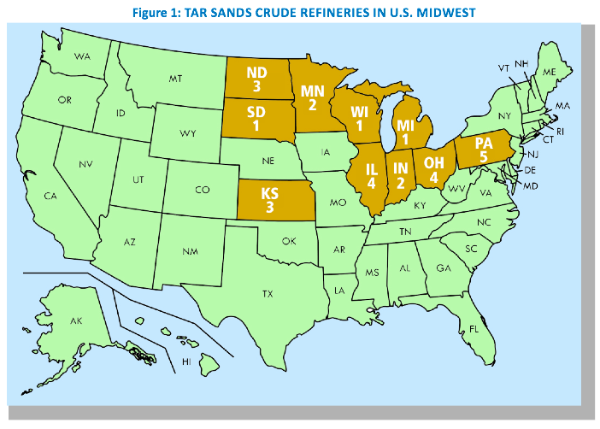What could possibly go wrong?

Photo by Anne C. Savage
Impending upgrades to crude oil pipelines that bring tar sands crude to the Midwest are sparking fears of a significant jump in crude oil shipments on the Great Lakes. A report by the Alliance for the Great Lakes has details of the impending oil glut, the potential devastating impact on the largest reservoir of fresh water on the planet, and their policy recommendations to prepare for it.
The risks posed by tar sands crude shipping on the Great Lakes are real, and proposals are in the pipeline that could make the lakes the next frontier for moving crude oil to a vast network of Midwest refineries. If granted, these proposals open the door to shipping large volumes of this unique and relatively new form of crude across the Great Lakes, and in so doing expose these waters to threats.…As the Great Lakes are also the source of drinking water for more than 40 million people, endeavoring to understand, gird against and respond to the effects of a potential oil spill on the lakes is vitally important. […]The movement of more and more oil across Great Lakes waters, as is now proposed, raises the specter of more spills and more damage. The region’s cataclysmic experience in the Kalamazoo River three years ago clearly showed that when an oil spill occurs, petroleum products differ greatly in how effectively they can be removed from the environment. Indeed, the manner in which tar sands are extracted, coupled with their composition in transit, present dual risks to the environment. […]
The physical makeup of tar sands crude creates a heavy substance that, during a spill, can sink to the riverbed or lakebed rather than float on the water. The resulting, disturbing characteristic of ‘’tar sands crude” is that it is extremely difficult, potentially even impossible, to completely remove from the water after a spill. The Kalamazoo River, a Lake Michigan tributary, still suffers the effects of a tar sands crude pipeline leak, even after three years and more than $1 billion spent on cleanup. Much of the complexity of the Kalamazoo cleanup results directly from the heavy tar sands crude sinking to the bottom of the river. Responding to a spill of that magnitude in the deep waters of the Great Lakes would be even more difficult.
The report shows that new improvements to Enbridge Oil’s Line 67 pipeline will increase its capacity from 450,000 barrels per day (bpd) to 570,000 bpd. Line 61 which will receive this crude is being improved to handlefrom 560,000 bpd, up from its current 400,000 bpd. The 10,000 bpd discepancy will be taken up by other transportation methods. While overland rail is one of them, the report suggests that the low cost of transporting by ship will result in far more petroleum crude being carried on the Great Lakes.
Calumet Specialty Projects is interested enough that it’s looking into building a new “crude oil loading dock on Lake Superior, near its Superior, WI refinery, designed to load ships with heavy Canadian and light Bakken crude oil for shipment through connecting waterways.”
The crude is being taken to refineries and there are 19 of them on the Great Lakes:

[Graphic courtesy of the Alliance for the Great Lakes]
Those of us who live in the Great Lakes basin have a responsibility to protect this international treasure. Hopefully policy makers in the region will heed the recommendations in this report and do the right thing. Given the massive clout wielded by the Big Oil lobby, I fear that may not happen.
[H/T Steve Horn | DeSmogBlog.com]



